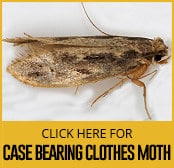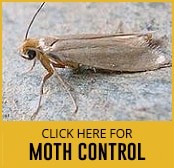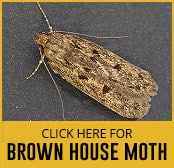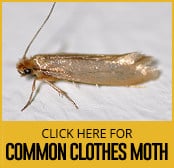Need Help? Call us on 0161 776 9832 or drop us an email for expert pest control advice on how to identify pest infestations and help solve your problem.
Moth Control
Latin Name - Order Lepidoptera
What They Look Like
Though moths tend to look very different in appearance and size, the visual aspect is as far as it goes. Your typical moth has two wings, each covered in fine scales which, depending on the moth, maybe spectacularly colourful or quite dull, composed chiefly of greys and browns. So the kind of moth you're likely to find in your home will be under an inch in size and quite dull in colour.
What They Eat and How They Behave
Though moths are more or less built the same despite their visual differences, their behaviour and diet are as varied as their colours. For example, certain moths can be a significant problem for agriculture, while others cause little to no issues for people to save for the occasional fright. Some moths serve an essential role in pollinating various plants, while others feed on the blood of animals. Finally, they serve as a food source for many larger animals of all types, from lizards to spiders. In the home, you're most likely to find a moth nibbling at your stored food, something that the Brown House Moth Hofmannophila pseudospretella is known for!
Moths have built themselves something of a bad reputation for eating away at clothing (such as the Common Clothes Moth Tineola bisselliella) that has spent a long time in the cupboard. Still, in truth, moths will ruin just about anything, including fur and feathers, especially if the moth is a Case-Bearing Clothes Moth Tinea pellionella.
Despite a penchant for flying into light bulbs, moths prefer the dark and will often be found in places like closets, and attics, snoozing away in bits of fabric, such as curtains or old clothing. Due to their largely passive nature, they can often grow to substantial numbers in a location before ever being noticed by a person.
The kind of moth that eats your favourite jumper is known as the Common Clothes Moth Tineola bisselliella or a webbing cloth moth, and it is their larvae that do the damage, not the grown moth itself. They are picky, though, and prefer animal-based clothing, such as woolly jumpers, over their synthetic counterparts.
Other than the aforementioned wardrobe-ruining activities, moths are generally considered to be harmless to people directly. However, they can be annoying, and a not-insignificant number of people will be scared of them. Despite this perception, some moths are more troublesome, such as the saddleback caterpillar moth, the Io moth, and the southern flannel moth, as their larvae can sting! The most significant area of concern over moth behaviour is agriculture, though, where a considerable moth infestation can cause severe damage to crops. For example, Diamondback moths, Codling moths, and Gypsy moth caterpillars are a nightmare to cabbage, fruit, and forested areas, respectively. Other moth larvae (known as cotton bollworms, tomato fruit worms, and corn earworms) have consumed tomato, cotton, and corn. This is also something the Brown House Moth Hofmannophila pseudospretella is known for.
How They Get In Your Closet
Aside from the most apparent method of flying through an open door or window, moths can also find their way into your home via an infested medium that is brought in, such as food products, plants, or clothing. Plants especially are susceptible to White-shouldered House Moth Endrosis sarcitrella, which eat plant life and other organic debris.
Tips to Prevent an Infestation
A good starting point for preventing moths from getting into your home is to check over food brought into the house, which goes double for grain-based foodstuff and pet food. Also, be sure to check any fabrics entering the house, be they clothes, rugs, furniture, etc., the latter being more the purview of the Case-Bearing Clothes Moth Tinea pellionella. It may also help limit the use of outdoor lighting as much as is feasible, as the lights tend to attract moths at night.
The Signs of a Moth Infestation
Unfortunately, many of the signs of a moth infestation are only detectable after the infestation is underway. The symptoms vary depending on what species of moth you are dealing with. For example, typical indoor moths can be seen by the adults flying around the room, whereas moths that eat fabric tend to be noticed by the mess they make of your wardrobe. Plant-eating moths such as the White-Shouldered House Moth Endrosis sarcitrella can be seen by the damage caused to the plant life around the house. Sometimes webbing or droppings may be noticed as well.
If you're having problems with Moths on your property, contact us immediately. We cover the whole of:




